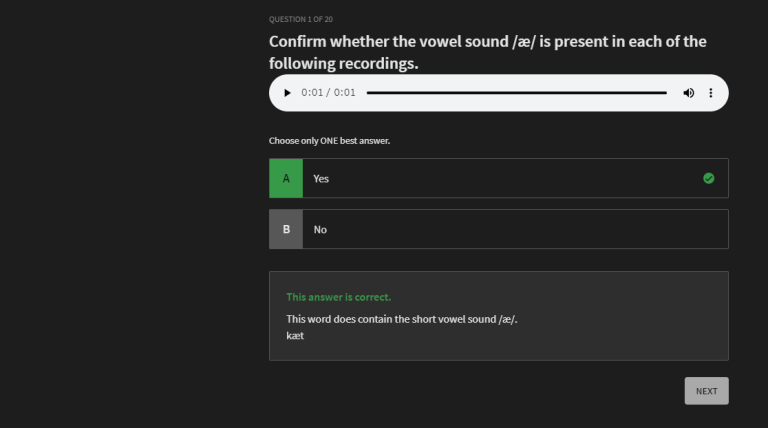Received Pronunciation: Complete Course
Learn the accent spoken by British newsreaders, presenters, journalists, and the top British actors in Hollywood.
My program starts with the simplest sounds progressing all the way to native-like sentence structures. The course strikes a balance between detailed explanations and practical exercises.
Let's Start with the Basics
If we truly want to achieve a native-like accent, we need to start by learning to recognise the basic sounds. I have done my best to optimise the learning process by introducing the content in a specific order. There’s no need to memorize anything; earlier concepts will be revisited later through a series of exercises and quizzes.
Think Like a Native
While many prefer to dive straight into practical exercises, I believe that this approach is what hinders their ability to improve. The oversight lies in neglecting the subtle nuances that native speakers inherently grasp.
Learners tend to overcompensate, attempting to replicate sounds through the lens of their native language. My aim is to help non-native speakers replicate the sounds through the lens of a native English speaker.
A Basic Overview
Chapter I starts with an introduction to the tools that we will be using throughout this course:
The International Phonetic Alphabet
The Vowel Sound Chart
The International Phonetic Alphabet is a phonetic script that provides us with an accurate representation of the sounds of English. The vowel sound chart helps us identify the positioning of the tongue for each vowel sound.
We’ll also take a brief look at:
- Syllable Stress
- Aspiration
- Stop Consonants
- The Schwa Sound
- The Feedback Loop
- The Language Filter
- Muscle Memory
These concepts will be explored in more detail as we progress through the course.

The 20 Vowel Sounds & the 24 Consonant Sounds
We’ll explore the unique sounds of British English, comparing similar but distinct sounds, to finely tune our ears to these subtle differences.This will result in better perception and awareness which is what will adjust our language filter.
We should ask ourselves:
- Where is the phoneme located on the vowel sound chart?
- Where do we position the tip of the tongue?
- Which facial muscles are we using?
- How does the target sound compare to similar vowel sounds?
We’ll also study the consonant sounds. Non-native speakers often struggle to articulate consonant sounds in a native-like manner due to differences in the aspiration mechanisms and the use of the articulators. We’ll explore the interaction between the mouth, lips, teeth, tongue, and lungs and how it plays an important role in producing the consonant sounds of RP.
Exercises to Help You Identify the Target Sound
Before engaging in more hands-on exercises, we need to identify, isolate, and differentiate the sounds of English.
Ask yourself the following:
- Can I recognize the target sound in isolation?
- Can I distinguish the target sound from sounds that are similar but different?
Listening exercises start with single-syllable words and gradually progress to more complex sentence structures. The exercises are designed to help you become more attuned to the subtle nuances.

Stress Patterns & Natural Rhythm
Each section includes a vowel training exercise to help you become more accustomed to the concept of stressed and unstressed syllables. The pattern below features a two-syllable word repetition exercise.
Our attention is brought to the following:
- The first syllable is stressed and contains the front vowel sound /æ/ which forces the mouth wide and open.
- The second syllable is unstressed and contains the schwa sound which commands a relaxed facial posture. There is minimal movement in the mouth and lips.

Muscle Memory Workout
Train your articulators to become more adept at repeating the sounds of British English pronunciation.
Muscle memory allows you to automate the correct pronunciation of sounds. When you repeat the same exercises, over time your muscles will learn to respond correctly without requiring conscious effort. You’ll be able to focus on what you are saying rather than the mechanics of your pronunciation. As a result, you will be able to speak more confidently and naturally.
You will be able to produce the sounds of British English more consistently, even when speaking at a faster pace. Your accent will sound more natural and increase your overall comprehensibility to native English speakers.
Lesson PDFs & Discussion Forum
You’ll have access to clear and concise PDF documents with explanations and diagrams.
For any questions, you can directly reach out to me through the discussion forum.

Unique Video Content
In addition, the course includes content highlighting the natural patterns of speech of native English speakers.
Watch videos with up-and-coming actors and business experts. Pay close attention to their speech and see if you can identify the target sounds.
Sign up for a Free Preview
Sign up for a free preview before making a purchase. English, Japanese, and Russian subtitles (where available).
Learn Received Pronunciation by visiting:
FAQ
Who is the target audience for this course?
This course is tailored for non-native English speakers aspiring to master Received Pronunciation.
What is Received Pronunciation?
Received Pronunciation, as defined by the Cambridge Dictionary, is “the standard way in which middle-class speakers of southern British English pronounce words.”
Can native English speakers benefit from this course?
Certainly! Native English speakers can find value in this course, as it covers common aspects among various English accents. However, some concepts might already be familiar to native speakers, such as those who speak General American English. For instance, individuals accustomed to aspirated consonant sounds might find these aspects covered in the course unnecessary. Nonetheless, the course provides valuable insights and techniques for mastering accents beyond one’s native dialect. Speakers of General American English are recommended to explore the Student Correction Course for a more tailored experience.
What is the expected duration of the Complete Course?
The average completion time for this course, based on feedback from previous students, ranges anywhere between 20-60 hours, depending on individual progress.
Why is the Complete Course so lengthy?
This course goes beyond teaching the sounds of Received Pronunciation; it aims to help students internalize them. Concepts introduced earlier are revisited in greater detail later in the course. Alongside quizzes and exercises, there are numerous listening, shadowing, and muscle memory exercises included.
Is there a time limit to complete this course?
No, students enrolling in this course will enjoy lifetime access.
Are there any prerequisites for taking this course?
While no specific prerequisites exist, a basic level of English proficiency is recommended for optimal learning. Most videos include English subtitles, and subtitles in other languages are also provided.
Can I access the course materials on any device?
Absolutely, the course is accessible on any device with an internet connection using a web browser.
Is there any support provided during the course?
Yes, a dedicated support team is available to assist students with any questions or issues they may encounter during the course.
Is the course self-paced?
Yes, the course is self-paced. Students can progress through the material at their own pace.
What happens if I need to take a break from the course?
You can progress and resume later; the course will pick up where you left off.
Are there any future discounts available for this course?
The Complete Course is priced at its best rate, offering exceptional value for money. Additionally, any future content and upgrades added to the course will be provided at no extra cost.